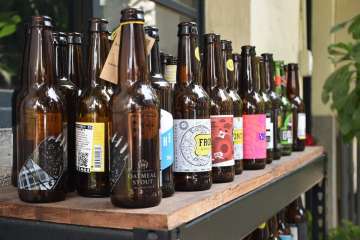Researchers have discovered extremely harmful levels of toxic carcinogenic substances such as lead, cadmium and chromium in the enamelled decoration of beer, wine and spirits bottles.
The team at the University of Plymouth analysed both the glass and enamelled decorations on a variety of clear and coloured alcohol bottles readily available in shops and supermarkets.
The enamels were of greater concern, with cadmium concentrations of up to 20,000 parts per million in the decorated regions on a range of spirits, beer and wine bottles and lead concentrations up to 80,000 ppm in the decor of various wine bottles.
The limit for lead in consumer paints is 90ppm.
"It has always been a surprise to see such high levels of toxic elements in the products we use on a daily basis. This is just another example of that, and further evidence of harmful elements being unnecessarily used where there are alternatives available," said Andrew Turner, Associate Professor (Reader) in Aquatic Geochemistry and Pollution Science.
"The added potential for these substances to leach into other items during the waste and recycling process is an obvious and additional cause for concern," he added in a paper published in the journal Environmental Science and Technology.
The study also showed the elements had the potential to leach from the enamelled glass fragments and when subjected to a standard test that simulates rainfall in a landfill site.
For the current research, bottles of beer, wine and spirits were purchased from local and national retail outlets, with the sizes ranging from 50 ml to 750 ml.
Out of the glass from 89 bottles, 76 were positives for low levels of lead and 55 positive for cadmium. Chromium was detected in all green and UVAG bottles, but was only in 40 per cent of brown glass and not present in clear glass.
Meanwhile, the enamels of 12 products out of 24 enamelled products tested were based wholly or partly on compounds of either or both lead and cadmium.
"When we contacted suppliers, many of them said the bottles they use are imported or manufactured in a different country than that producing the beverage.
"This poses obvious challenges for the glass industry and for glass recycling and is perhaps something that needs to be factored into future legislation covering this area," said Turner.
ALSO READ | UK likely to ban social media firms over toxic content
ALSO READ | Mumbai: BMC worker dead after inhaling toxic gas in sewage tank
Latest World News

